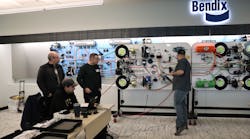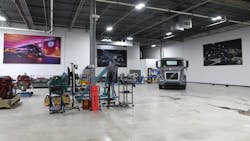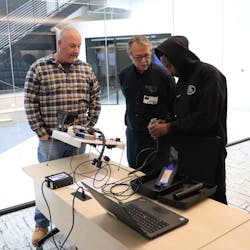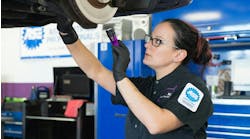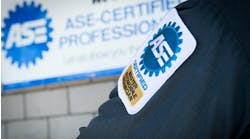This is Part 3 of a Fleet Maintenance's 3-part series on hiring and retaining technicians in the commercial vehicle sector. Read Part 1 here. Read Part 2 here.
The complexity of commercial vehicles never stops growing and could completely shift in the next few decades from internal combustion to electric powertrains. Technicians need to keep up, so education must continue from the apprentice level to master tech and beyond. From a business side, this will help a shop take on more work and improve uptime. For the employee, upskilling helps build confidence, reduce monotony, and better their chances at advancement.
But finding classroom time for a tech who could be in the bay working has proven difficult for many shops.
“I think our biggest struggle is getting shops to spend the time and money to actually send their technicians to a training class somewhere because it’s not cheap,” said Tyler Robertson, CEO of Diesel Laptops. “And they’re already short-staffed with trucks broken down. Now we’re trying to get them out of the shop for a couple of days to go to this class, so there’s a continuous loop of just not enough resources and time to deal with it.”
According to the 2022 ASE Training Managers Council (ATMC) Training Benchmarks Survey, 60% of fleet technicians said they did not have enough access to training. Truck technicians specifically cited electrical/electronic and engine performance as the most needed training content.
Robertson noted that diagnosing issues with emissions systems and onboard computers requires such training, and even experienced techs don’t always have the basic skills needed. That’s a reason Diesel Laptops offers virtual training to the industry.
A pretest on the basics of electrical work, from Ohm’s Law to how to use a multimeter, illuminated the overall problem to Robertson.
“On one, 80% of the students failed,” he exclaimed. “These are not like brand-new students out of school. These were all people that have been in the industry for years, so we stopped giving the pretest because hardly anyone would pass the thing.”
For Pitt Ohio, honing in on electrical training will be increasingly important as it adds more electric vehicles to its LTL fleet. The company just received two Class 7 Volvo VNR Electrics to operate in the Cleveland area. It has extended service agreements with a Volvo dealer, but at some point, the fleet wants to do its own warranty work on them, and that will require electric vehicle training. Volvo has eight Volvo Trucks Academy Learning Centers across North America to complete the battery-electric truck training.
“All these high-tech vehicles are going to need really good people to maintain them, and we’re going to have a bigger problem than our supply chain issue if we can’t invest in these young folks,” said Taki Darakos, Pitt Ohio's VP of maintenance and fleet services .
He also noted one key to success in this area will be to ensure techs have the skill level and interest to get value from the training.
“There could be somebody that’s really competent and really sharp, but if they don’t want to go there, that would be a bad choice from the start,” he said. “Because I think you need somebody willing to learn and grow, and they’re going to be engaged and understand that it’s not all going to be roses, and there’s probably going to be some hiccups and hang-ups.”
Pitt Ohio also has vendors come on-site to perform training on safety, tires, and brakes and also has technicians go out to OEMs to learn about specific engines.
Overall, Darakos said techs need 30 to 50 hours of professional development a year to keep from getting behind.
Training is a huge component of Bendix Commercial Vehicle Systems’ plan to serve customers and make the roads safer through its advanced driver assistance systems, electronic roll stability, brakes, and other related components. In fact, the centerpiece of the OE’s new headquarters in Avon, Ohio, is a large, glass-enclosed classroom filled with dynamic training boards that include functioning air and electrical systems.
Unlike with a static drawing, someone trying to learn about these pneumatic and electronic systems can see how exactly how systems integrate with each other, much like doctors learn about living organs by working on corpses. The difference here is that these systems are still alive thanks to shop air and an electric cord. These “air boards” can also be rolled onto trailers and delivered to fleet facilities or other training locations.
They were getting plenty of use at a recent two-day training event at the building, which fully opened in April. A few dozen technicians from various fleets filled up the room to learn how to work with the OE’s product lines. On day one, they covered air disc brake maintenance and performed a Tappet Boot replacement; on day two, they spent several hours going over ADAS troubleshooting, talked through specific sensor issues, and watched some videos on the Bendix ESP electronic stability technology followed by a technical discussion.
After lunch, in likely one of the industry’s most stunning cafeterias, the fleet technicians reconvened and broke into teams to test their diagnostic acumen on the air boards as well as other hands-on troubleshooting exercises.
“A technical mind is a visual learner—I know mine is,” offered Brian Screeton, Bendix supervisor of technical training. “And I can talk about it all day, but if I can show them up there, and then come over [to the air board] and actually show them how things flow, how things work, where the air is going, what it’s doing—that really cements it in. And I love seeing that light coming through.”
One huge loss during the pandemic was preventing techs from in-person learning like this, which has no substitute. Not only do learners get to work with actual components under the supervision of OE experts, they learn from each other.
“We did a lot virtually through COVID, but one of the huge benefits of being back in person is that people feed off each other,” noted Nicole Oreskovic, Bendix VP of marketing, product planning, and sales operations. “And one question may lead to another question to another question.”
“Chances are they’re not the only ones that may have experienced that same issue or have that question,” she continued. “It’s no different than when you’re in grade school, and your teachers encourage you to ask a question because everyone in the class learns from it.”
To borrow from Pitt Ohio’s Darakos and his simile about training techs being like nurturing plants, training techs together is an act of cross-pollination to ensure the whole field will thrive.
“The benefits are you get everybody’s perspective and experiences in one room,” Screeton said. “And they’re always different. Maybe you were troubleshooting and you didn’t get it—let’s bring it up and we’ll talk about why we can solve it in the class.
Getting techs up to speed won’t only help their fleets manage downtime and get ahead of problems; it ensures trucks’ emergency braking works as intended, or that a trailer won’t tip over. And overall, it’s making stronger diagnosticians, which is where the industry is heading.
“Especially as the products are evolving, and the systems are getting more complicated, it’s important to understand how they work so [technicians] can troubleshoot them effectively,” Oreskovic said. “[This ensures] that when they are doing maintenance or having replaced a part, they’re replacing the root cause of the problem and not something that’s just a symptom of it.”
